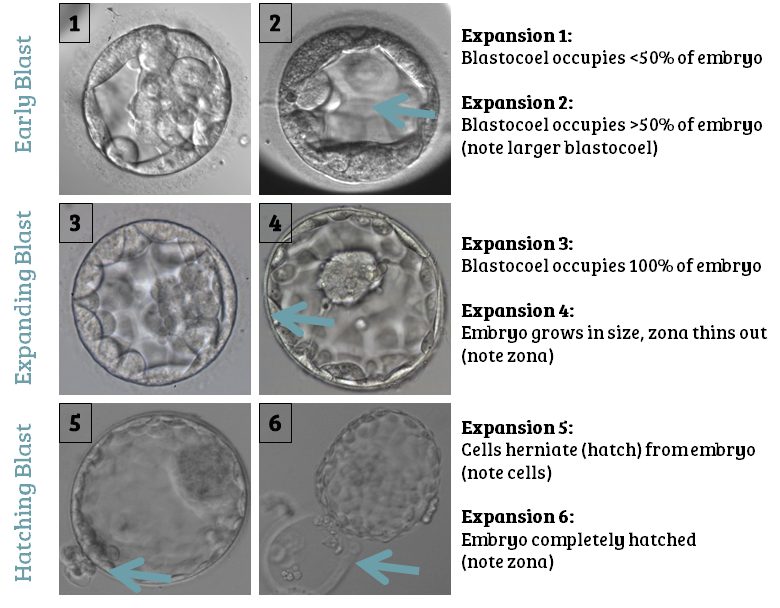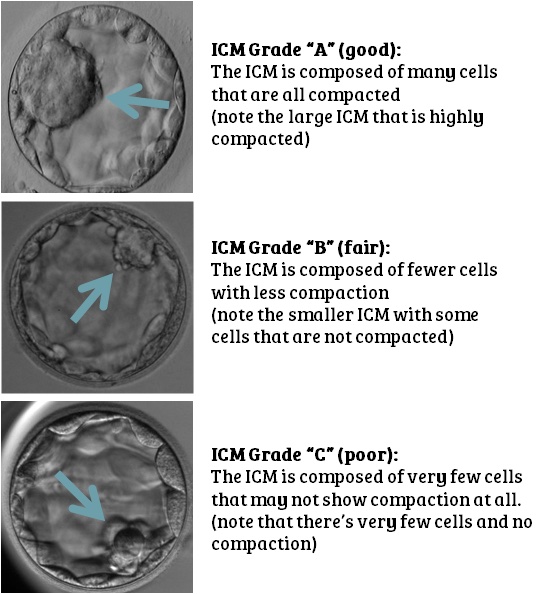Embryo evaluation, part 3: Blastocyst stage embryos

In the last two posts I covered embryo development and cleavage stage grading.
Now we’re going to get to the real juicy stuff: blastocyst grading!
Just a quick recap.
On Day 0 the egg is fertilized and this fertilized egg then divides (or “cleaves”) over the next few days. On Day 1 there’s about 2 cells, on Day 2 there’s about 4, and on Day 3 there’s about 8. This is called the “cleavage stage”. On Day 4 or so these cells compact to form what’s called a morula. Then, around Day 5 this morula will form a blastocyst.
To grade blastocysts we look at three things: the expansion (or how big it is), the quality of the inner cell mass (ICM), and the quality of the trophectoderm. This gives us a number followed by 2 letters: a 4AB for example. The number is the expansion.
A blastocyst is characterized by having a blastocoel. This is a special structure that’s a lot like a water balloon inside the embryo. It fills with water and lets the embryo expand and contract. This might help the embryo ultimately hatch from its zona (shell).
The expansion of an embryo partly depends on how big the blastocoel is. In an early blast, so embryos that are “1” or “2”, the blastocoel occupies <100% of the embryo. A “3” has a blastocoel that fills up the entire embryo. You can see this below:

Expansion 4 has to do with how thin the zona is. As the embryo grows in size, the zona stretches out and becomes thinner. Eventually the cells of the embryo pop out, or hatch from the zona and it becomes a “5”. Once the embryo is fully hatched it’s a “6”.
The ICM is the first letter in the blastocyst grade (so an “A” in a 4AB) and is the part of the embryo that becomes the fetus! It’s evaluated based on how many cells and how compacted they are. Check the image below to see how an A quality (good) compares to a C quality (poor) ICM.

The trophectoderm is the second letter in a blastocyst grade (so a “B” in 4AB) and is the part that becomes the placenta. Like the ICM, it’s graded based on how many cells there are and how compacted they are. See below to compare the qualities.

That’s pretty much it for blastocyst grading! It takes a lot of practice to do it right but is pretty remarkable once you get the hang of it.
If you’re needing help with grading I offer evaluations and a video course to help people better understand their embryo pictures and reports – check it out here https://www.remembryo.com/embryo-grading-request/. Also check me out on Instagram! https://www.instagram.com/embryomanofficial/
I have a private Facebook group also where you’ll find a lot of help from some really awesome members: https://www.facebook.com/groups/embryologyandivfsupport
Recent blog posts
Excerpt from the memoir “How to Get a Girl Pregnant”
Waiting. Waiting. Waiting. Can I fill up the day with 16 separate tasks so that I don’t think about waiting?
Just Adopt
There’s really no escaping it. When you’re facing infertility, other people getting into your business begins to feel pretty routine.
Four things I’ve learned about having a baby in my 40s
As many of us that have struggled to get pregnant know, life doesn’t always go the way you expect it to.




